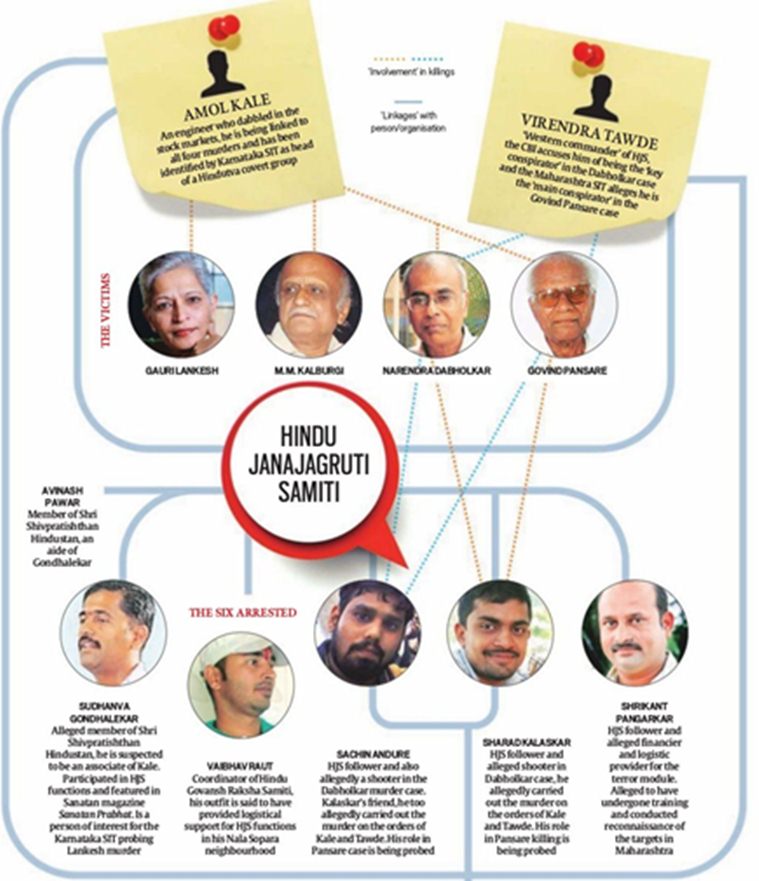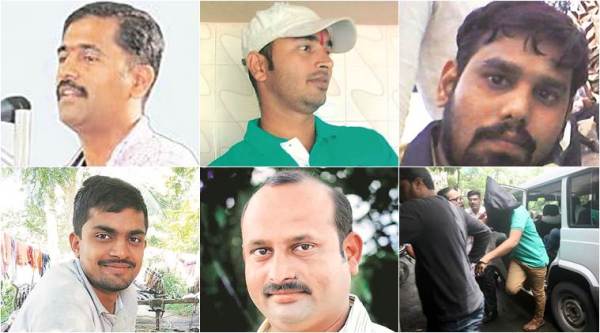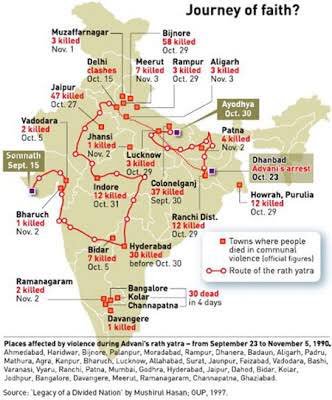The Maze
Six recent
arrests by the Maharashtra Police and the CBI point to a complex and
intricate web of fringe Hindu radical groups whose members are now being
linked to four murders and a recently busted terror module. The Indian
Express untangle the plot
Written by
Rashmi Rajput
,
Johnson T A
|
Updated: August 26, 2018
Four murders, a terror plot, two state police forces, multiple crack
teams, numerous suspects and a diary that connects them all.
This diary, recovered from the Pune residence of Amol Kale, a
former Hindu Janajagruti Samiti convenor and an accused in the
September 2017 murder of journalist
Gauri Lankesh,
contained coded entries and numbers, which, investigators claim, has
brought them close to cracking the 2013 murder of rationalist Narendra
Dabholkar. In the process, sleuths claim to have unearthed a terror
module whose members, affiliated to fringe Hindu radical groups, were
allegedly planning to carry out bomb blasts across Maharashtra.
Also read | Five held now for ‘terror plot’, ATS prepares fresh dossier for Sanatan Sanstha ban
On August 10, the Maharashtra Anti Terrorism Squad (ATS) announced
the arrests of three members of this module — Vaibhav Raut, 40, an
alleged member of the Hindu Govansh Raksha Samiti and an alleged
sympathiser of the Goa-headquartered Sanatan Sanstha; Sudhanva
Gondhalekar, 39, who hails from Satara and is a member of the Shri
Shivpratishthan Hindustan; and Sharad Kalaskar, 25, a follower of Hindu
Janjagruti Samiti (HJS). The ATS also went on to arrest former
Shiv Sena corporator Shrikant Pangarkar and another alleged member of Shri Shivpratishthan Hindustan Avinash Pawar.
During interrogation, Kalaskar is said to have confessed that he and
Sachin Prakashrao Andure shot Dabholkar. Following this, the CBI, which
is investigating the case, arrested Andure, a member of the HJS.
“Since June, Karnataka’s Special Investigation Team (SIT) probing
Lankesh’s murder shared certain numbers mentioned in Kale’s diary and
these were put on surveillance by the Maharashtra ATS. It was while
intercepting calls exchanged between these numbers that investigators
learnt of the conspiracy to carry out blasts. On August 7, ATS officers
closed in on the suspects. Accordingly, raids were conducted in Nala
Sopara and Vaibhav Raut and Kalaskar were detained for questioning,”
said a senior Home Department official.
Also read | Gauri Lankesh murder case: Maharashtra accused ‘pops up’ in footage
 Click to enlarge.
The web
Click to enlarge.
The web
Over the last year, while probing Lankesh’s murder, the Karnataka SIT
found that the journalist was shot with guns used in the murders of
Dabholkar in Pune on August 20, 2013, Leftist thinker Govind Pansare in
Kolhapur on February 16, 2015, and Kannada scholar M M Kalburgi in
Dharwad on August 30, 2015.
The investigations in the Lankesh case have also led police to the
door steps of people, who on the face of it, seem to belong to fringe
groups such as the Shri Shivpratishthan Hindustan but are deeply
associated with overground and underground activities of the Sanatan
Sanstha and its affiliate, the HJS.
The Sanstha was established in 1999 by Jayant Athavale, a
hypnotherapist, to promote Hindu religion. The aim of the trust is “to
impart spiritual knowledge to the curious…, inculcate religious
behaviour in the masses and provide personal guidance to seekers for
their spiritual upliftment”. The HJS, which is a branch of the Sanstha,
was set up in 2002 with the intention of establishing a “Hindu Rashtra”
in India. It is also headed by Athavale. However, the Karnataka SIT has
for operational reasons refrained from officially naming the Sanstha and
HJS in the murders of Lankesh and others. While the six persons
arrested in Maharashtra recently are members of different groups, their
social media profiles show that they attended functions organised by the
Sanstha and HJS. For instance, Raut was a regular at the annual
conclaves held by the Sanstha in Goa and his local gau rakshak group
provided logistical support to programmes organised by the Sanstha in
Nala Sopara.
Read | Among six arrests, a cow vigilante, Dabholkar ‘shooter’
Gondhalekar, whose role in the Lankesh murder case is being probed by
the Karnataka ATS, is documented on the HJS website — with pictures —
as a frequent attendee in programmes, including press conferences.
According to a report and photograph on the HJS website, Gondhalekar
held a press meet in September 2016 to accuse Dabholkar of financial
fraud.
“Pangarkar was also associated with the HJS. The
Facebook
profiles of Kalaskar and Andure show that they were affiliated to the
HJS and they both knew Tawde. When all of this is pieced together, the
probe points not only to the HJS but also Sanatan Sansthan,” explained
the official.
 The six arrested; (clockwise from top left) Sudhanva Gondhalekar,
Vaibhav Raut, Sachin Andure, Sharad Kalaskar, Shrikant Pangarkar and
Avinash Pawar.
The six arrested; (clockwise from top left) Sudhanva Gondhalekar,
Vaibhav Raut, Sachin Andure, Sharad Kalaskar, Shrikant Pangarkar and
Avinash Pawar.
The Sanstha and HJS have, in fact, tried to remove links from their
websites of association with several persons recently arrested by the
Karnataka SIT and authorities in Maharashtra for their alleged roles in
the four murders and for reportedly planning fresh shootings and acts of
terrorism.
Of the 12 persons arrested by the Karnataka SIT in the Lankesh case,
the most glaring association with the Sanstha is that of Amit Degwekar,
38, who claims to be a proofreader for Sanstha mouthpiece Sanatan
Prabhat, but was described by then Sanstha spokesman Abhay Vartak as a
promoter of the magazine.
Degwekar was arrested by the Karnataka SIT on May 20, 2018, along
with former HJS Pune convenor Kale and HJS sympathiser Manohar Edave on
the basis of investigations that indicated that Kale alias Bhaisaab was a
key player in the operations to kill Lankesh.
Investigation revealed that Degwekar was a key component of a group
headed by Kale which has allegedly been involved in murders and
subversive activities since 2012, and used youths from fringe groups
allied to the Sanstha and HJS, sources in the SIT claimed. While denying
any connection between those allegedly involved in the Lankesh killing
and the Sanstha, its spokesperson Chethan Rajhans said, “Degwekar is a
promoter of Sanatan Prabhat. He used to visit the ashram for work. The
Sanstha is involved in spiritual enhancement of Hindus. We are not
killers.”
Unlike Degwekar, the links of the others to the HJS and the Sanstha can be disputed.
Kale, an engineer by profession, is being linked to all four murders
and has been identified by the Karnataka SIT as the head of the Hindutva
covert group. The HJS website has references to Kale as a member of the
group and a convenor for the Pune region until 2009-10. Following
Kale’s arrest in May, HJS spokesperson Ramesh Shinde said that Kale had
not been associated with the group over the last 10 years and that he
left it around 2008 for “personal reasons’’. The Karnataka SIT has,
however, found that Kale’s family in Pune is still closely associated
with the Sanstha and HJS. His child, they say, has been designated by
the Sanstha as a gifted child with a “high spirituality quotient since
birth”. In 2017, Gondhalekar’s children too were similarly designated by
the Sanstha as having “high spiritual quotient” though, according to
spokespersons for the Sanstha and HJS, Gondhalekar is not directly
linked to either of the two groups.
“There are very few children who get this tag of spirituality… This
suggests an association with the group,” sources in the Karnataka SIT
said. Among the other 10 persons arrested for the Lankesh murder so far,
Sujeet Kumar, a recruiter for the covert group, is a former HJS
activist, who, the organisation claims, dissociated from the outfit
around 2012. There are, however, articles and photographs on the HJS
website of his participation in the organisation’s events.
Similarly, the HJS website has a write-up from 2008 featuring Suresh
Kumar alias Suresh H L, a man who allegedly accommodated Kale and
Gondhalekar at his home in Bengaluru around the time Lankesh was
murdered, at an HJS “anti-terrorism exhibition” held at a school in his
hometown in Karnataka.
Rajesh Bangera, 50, a government employee from Mangalore,who became
an arms trainer for the covert group around 2012, was among the early
trainees at arms and self-defence training camps conducted by the
Sanstha in 2001-2003. He lists the Sanstha among his ‘likes’ on
Facebook. Bangera’s friend Mohan Nayak, 50, who allegedly helped rent a
home for the Lankesh’s shooter and three members of his support team in
the Kumbalgodu area, too is associated with the HJS, according to his
social media profile.
The first person arrested in connection with Lankesh’s murder, K T
Naveen Kumar, a resident of Maddur in Karnataka, who was accused of
providing logistical support for the killing, was a leader of the Hindu
Yuva Sena. Ahead of his recruitment by the covert group headed by Kale,
Kumar was invited to attend the June 2017 edition of the annual All
India Hindu Adhiveshan organised in Ponda by the HJS and Sanatan
Sanstha. There are images on HJS’s social media accounts of Kumar at the
Goa convention.
Sources in the Karnataka SIT say that since 2009, when the Sanstha
and Hindu Janajagruti Samiti were directly implicated in the Margao
blasts, much of the subsequent covert activities were outsourced to
individuals from fringe outfits like the Hindu Yuva Sena, Sri Rama Sena,
Shri Shivpratishthan Hindustan and even former Shiv Sena members who
worked under the guidance of former HJS activists.
“Till the 2009 blast, many mainstream Hindu leaders used to attend
the conclaves organised by the Sanstha and HJS. After the Sanstha was
linked to the blast, the group began losing credibility and efforts were
made to create a wall between the subversive activities and overground
activities like the adhiveshan (national conclaves),” a source said.
Investigators in Maharashtra say that while the six men recently
arrested seemed to have “worked in silos”, they could be involved in
multiple cases.
“For instance, the five arrested were part of a module that was
planning to carry out blasts in five cities in Maharashtra but one of
them, Kalaskar, has confessed that he killed Dabholkar. This shows that
unknown to each other, they were involved in other cases,” said a senior
ATS officer on condition of anonymity.
“Going by Kalaskar and Andure’s confessions, they were the shooters
in the Dabholkar case and carried out the killing on the orders of Kale
and Tawde. While Tawde is a leader of the HJS and is currently an
accused in the CBI case probing Dabholkar’s killing, Kale has been
arrested by the Karnataka SIT in connection with the murder of Lankesh.
Tawde is also an accused in the Pansare murder case and there is a
strong suspicion that either the shooters are the same or are known to
the group. The shooters (Andure and Kalaskar) were trained by Bangera,
who has been arrested in the Lankesh case and is suspected to have
imparted weapons training to dozens of recruits, including the shooters
in the Dabholkar and Lankesh cases,” explained an official.
The road ahead
For now, the fate of the four murder cases hangs on the results of
the forensic test that is to be conducted on the fire arm recovered from
the residence of Andure’s friend in Aurangabad. If the Forensic Science
Laboratory confirms that the weapon was used in the murder of
Dabholkar, it could be a major breakthrough as the CBI has so far not
been able to lay its hand on it.
As part of the recent raids it carried out, the Maharashtra ATS
claimed to have recovered a cache of arms and ammunition, including 20
crude bombs and 16 country-made pistols. There is a possibility that the
guns used in the murders since 2013 are among these weapons since
Gondhalekar has admitted to having collected and preserved weapons after
Lankesh’s killing, sources in the Karnataka SIT said. Five year after
Dabholkar’s killing, the CBI is hopeful that they might finally recover
the murder weapon. “Despite having a cache of weapons, we suspect that
the accused used the same set of weapons in all the murders probably
because they were superstitious,” says a CBI official. In spite of the
confidence displayed by investigators, questions remain. For instance,
the Pune Police arrested Maharashtra-based arms suppliers Manish Nagori
and Vilas Khandelwal for Dabholkar’s murder but the two were not
chargesheeted for lack of evidence. Besides, the CBI and SIT suspected
that Sanstha members Sarang Akolkar and Vinay Pawar were shooters in the
Dabholkar case. The agencies had based this on eyewitness accounts, but
have1 now named Andure and Kalaskar as shooters.
As police claim that they have more or less pieced together the
conspiracy behind the murders, what remains to be seen is how they work
their way through this complex maze of characters and motives and
whether they have a water-tight case at the end of it.
The six arrested
Avinash Pawar: Member of Shri Shivpratishthan Hindustan, an aide of Gondhalekar
Sudhanva Gondhalekar: Alleged member of Shri Shivpratishthan
Hindustan, he is suspected to be an associate of Kale. Participated in
HJS functions and featured in Sanatan magazine Sanatan Prabhat. Is a
person of interest for the Karnataka SIT probing Lankesh murder
Vaibhav Raut: Coordinator of Hindu Govansh Raksha Samiti, his outfit
is said to have provided logistical support for HJS functions in his
Nala Sopara neighbourhood
Sachin Andure: HJS follower and also allegedly a shooter in the
Dabholkar murder case. Kalaskar’s friend, he too allegedly carried out
the murder on the orders of Kale and Tawde. His role in Pansare case is
being probed
Sharad Kalaskar: HJS follower and alleged shooter in Dabholkar case,
he allegedly carried out the murder on the orders of Kale and Tawde. His
role in Pansare killing is being probed
Shrikant Pangarkar: HJS follower and alleged financier and logistic
provider for the terror module. Alleged to have undergone training and
conducted reconnaissance of the targets in Maharashtra
The others
Durgesh Sawant: An email sent by Sawant, former spokesperson of
Sanatan Sanstha, ordering Tawde to “concentrate on Dabholkar” has been
cited in the chargesheet as the ‘beginning’ of the conspiracy to kill
Dabholkar.
Sarang Akolkar and Vinay Pawar: Sanstha ‘seekers’, wanted since the
2009 Goa blast. Were suspected to have played an active role in the
Dabholkar and Pansare murders. Were identified as the shooters in both
the cases, but with Andure and Kalaskar now being named as shooters,
status unclear.
Rudra Patil: Sanstha ‘seeker’, wanted since 2009 Goa blast. Suspected to have played an active role in Pansare murder.
Amit Degwekar: Resident of the Sanstha ashram in Ponda, Goa, he is
suspected to be the link between the Sanstha and activities of a covert
group headed by Amol Kale.







 The six arrested; (clockwise from top left) Sudhanva Gondhalekar,
Vaibhav Raut, Sachin Andure, Sharad Kalaskar, Shrikant Pangarkar and
Avinash Pawar.
The six arrested; (clockwise from top left) Sudhanva Gondhalekar,
Vaibhav Raut, Sachin Andure, Sharad Kalaskar, Shrikant Pangarkar and
Avinash Pawar.

